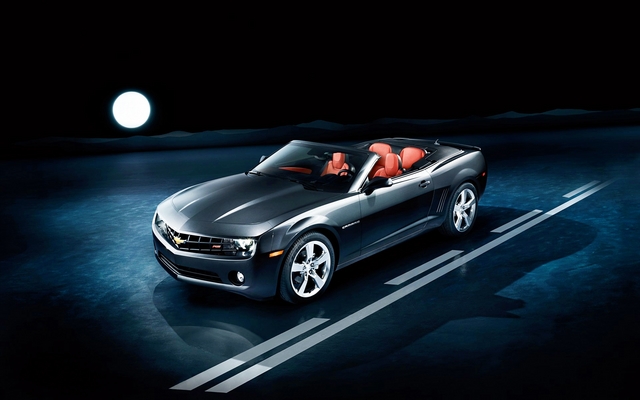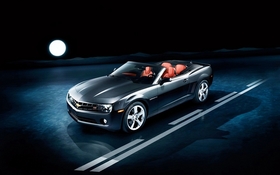The 2011 Camaro SS Convertible: Electronic Wizardy Goes Too Far

| Strong points |
|
|---|---|
| Weak points |
|
Lord, did I ever want to like this car. As a former Camaro owner never quite lucky enough to stumble upon the ’69 Z28 I always wanted, the notion of these new, retro Camaros has had me excited ever since Bumblebee leapt onto the silver screen a few years back. Initially, it was the news of a fire breathing SS variant outfitted with the lusty LS3 that had me exited, even if the LS3 only benefited from 376 cubic inches. Sure, it was a few short of the 396- and 427-cubic inch engines that any proper Camaro SS should have, but it reached for the redline with some exuberance, was made of aluminum, and most importantly of all, produced a fitting 426 horsepower. Having sampled it in a six-speed, manual gearbox equipped coupe, it was everything I’d hoped it would be: loud, brash, unapologetic, and feverishly addictive. I only wish the convertible had been half as good.
Then again, it wasn’t the convertible’s fault… not entirely. In fact, as far as convertible’s go, the Camaro’s pretty darn good. From stem to stern, the convertible’s lines are a definite improvement over its chief rival’s, be it top up or down, and although the top itself might not be the thickest, most robust design ever put into canvas, it does a decent enough job of keeping the wind (and the various noises it makes) at bay. The only downside would be its profile when stowed. Almost completely hidden below the car’s relatively tall beltline, it forms a set of awkward and uncomplimentary curves with the sheetmetal until you affix the tonneau cover; itself a task that I thought went out with Rick Astley and Hammer Time. Once that’s in place though, the whole thing looks very slick, as the angular coke-bottle shape of the Camaro and its broad, flat flanks lend themselves incredibly well to the removal of the roof.
And it’s not too bad inside. In fact, it feels just like the regular Camaro; at least with the roof up. Headroom isn’t diminished at all, and Camaro coupe drivers will already be well accustomed to the big blind spots that exist where both the coupe and convertible’s massive b-pillars reside. With the top down, wind management is decent, as the cars’ high sides and steeply raked windshield channel almost all of the passing air well over the occupants’ heads. Even at highway speeds, conversations were easy to hold and if long-haired passengers of the female persuasion had any complaints about hair mussing, I couldn’t hear them.
Although I easily could have, since even this, the burliest of V8-equipped Chevy musclecars, barely made a sound. In fact, the noises emanating from the Camaro’s belly were so untoward that I actually thought something was properly wrong with it. I poked, prodded, and slid underneath to examine all the various exhaust piping, but the internet held my answer: variable displacement technology, or what GM is calling “Active Fuel Management.” Yes, apparently, if you opt for the automatic gearbox in your Camaro SS, you don’t actually get the Corvette’s LS3 powertrain. What you DO get is an L99; a higher-tech, more “refined” version of the LS3. Sharing plenty of parts with the great LS-series V8, the L99’s biggest party piece is a set of lifters that can essentially be turned off and on, as needed, to allow the engine to run on 8, 6, or 4 cylinders with the obvious fuel economy benefits. According to GM, switching between displacements causes some form of driveline lash and vibration that’s best quelled with a carefully tuned torque converter, which explains this engine’s availability with the slushbox, but not the manual. And in order to keep the 4-, 6-, and 8-cylinder Camaro from sounding like a four or six cylinder Camaro, GM has installed an active (overactive?) exhaust system to quell the sound levels produced until all eight cylinders come on song. The result is a car that quite literally hisses nearly everywhere it goes, until you poke the throttle. But even then, there isn’t much consistency. Give it a halfway decent jab, and all you’ll get is an anemic, four (or maybe six?) cylinder splurt (for the resulting acceleration isn’t worthy of the term “spurt”) of speed accompanied by an even loader hiss…. Poke it a bit too far and it’ll drop two or three gears, roar to life with reckless abandon, and leap forward quite unpredictably. This bipolar mentality and strange soundtrack essentially reduces the Camaro’s LCF (look cool factor) to nil, since everyone can watch you drive past in the oddly (and quite loudly) hissing Camaro until you get fed up with it, only to inadvertently launch your way into traffic with a mighty roar and come to a stop at the next red light in a car that’s gone right back to hissing at you… just in time to gather some hateful stares from Starbucks-sipping onlookers that have obviously lumped you into the “stupid idiot” crowd.
And it’s not much better once you get it onto the highway. The throttle pedal still seems to be hooked up to the transmission rather than the throttle body, and inputs are still processed as if you’ve somehow done the car wrong in a manner that would see you appearing on the Maury show. Attempts to pass start innocuously enough that you may, in fact, forget that you were even trying to pass someone in the first place, but the moment you remember and give the gas pedal a bit more pressure, the car suddenly springs to life and catapults you past the offending BMW in a wave of crushing sound and fury that would make KISS shudder. As if that wasn’t annoying enough, since you’ve just shattered that BMW drivers’ ego in what he will obviously see as a clear display of arrogance and bravado, he’s going to spend the next ten kilometers attempting to give you a colorectal exam with his 335i. All in all, it’s like driving a four-wheeled, slightly less bad-ass version of Harry Callahan around with the way the car leaves you continuously guessing if you’re going to get all eight cylinders on this onramp, or only six.
And me personally, well, I’m just not a fan of getting continuously punched in the commute by a car that thinks it knows better than me. Thankfully, there’s a cure: it’s called a clutch... and ironically, it’s even more economical. Yes, after a week’s worth of sparring with the Camaro’s gas pedal in a seven-day long attempt to convince it to do what I asked, my fuel economy was expectedly poor… two litres per hundred kilometres’ poorer than that I experienced in the eminently better six speed manual coupe I drove last year. And that car sounded so good that the thought of being able to retract the roof and hear that exhaust note in true surround sound is still enough to make me salivate… even after driving a hissing cat around for a week.
Until GM builds an ECU that can actually read my thoughts, the reality is that the driver will always be a step ahead of the computer. I’ll always be able to prepare for a situation I am approaching, and I’ll always be able to respond in the manner I choose, rather than giving the car a series of inputs and hoping for the correct response. And although electronic nannies, overactive automatic gearboxes, and quasi-fuel saving countermeasures may make sense on vehicles that are all expected to be driven in the same manner (minivans, family sedans, et. al.), sticking such features on a car that may be driven to work one day and to a track day the next simply doesn’t work. No, if you’re seriously considering driving away in Camaro SS, do yourself a favour: use your left leg to do it.











